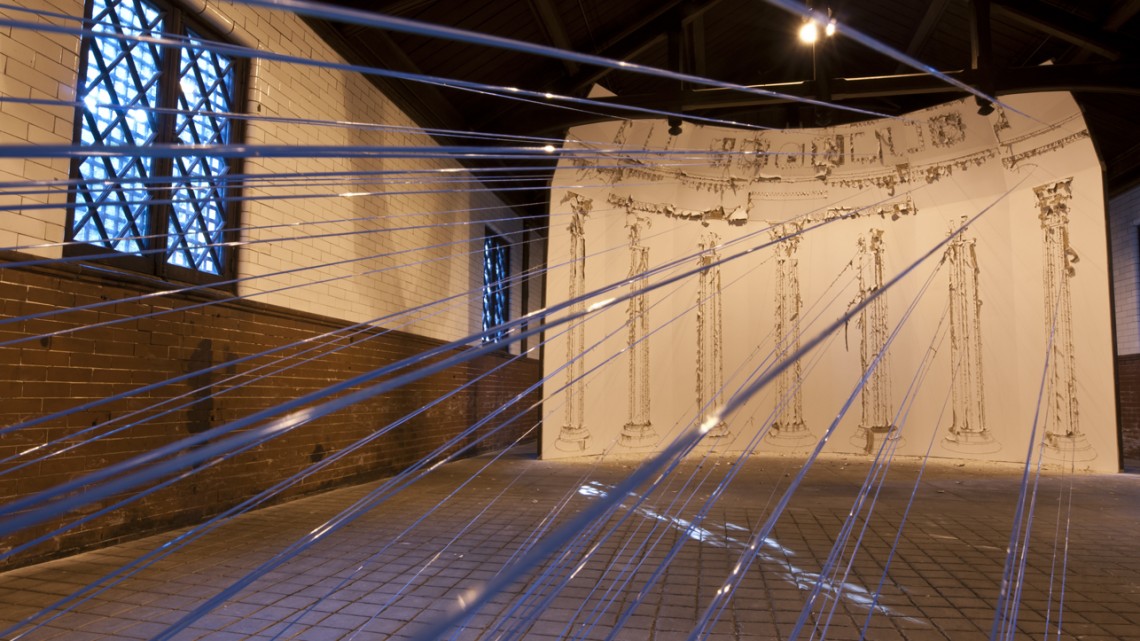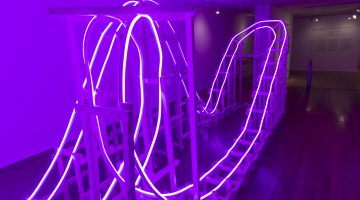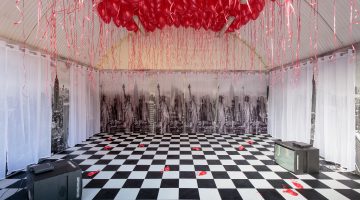Artist Jesse Potts creates kinetically dynamic works that address tangible perceptions of decay. Through the use of complex mechanics that literally rip away at the drywall and draw new delineations of space, hidden structures become revealed over time. Referencing both the classical iconography of columns and everyday observations and occurrences, Potts makes evident the fragility of things that we take for granted.
I am curious to know what kinds of readings/books you study or collect that inform your work and how these might be influential to you?
Right now, I really like Georges Perec’s Species of Spaces. It is a great reminder to be observant to the point of exhaustion. This is something fresh in my mind because I work with students, many whom are new to art. To be a good writer one must be a good reader. But according to Perec you must also be willing to examine your subject matter on a macro and micro level and become well practiced in the act of perception. This skill helps me to remember to slow down, to examine things with a little more depth and to look for analogous relationships. I like the way Perec is devoted to analyzing the banal, the private space and the public space—not unlike the way Gaston Bachelard is able to draw beautiful analogies between the home and the psyche in The Poetics of Space. Also, I like the way Juhani Palassma writes with urgency about architecture and the ways he re-asserts the importance of the artist’s hand.
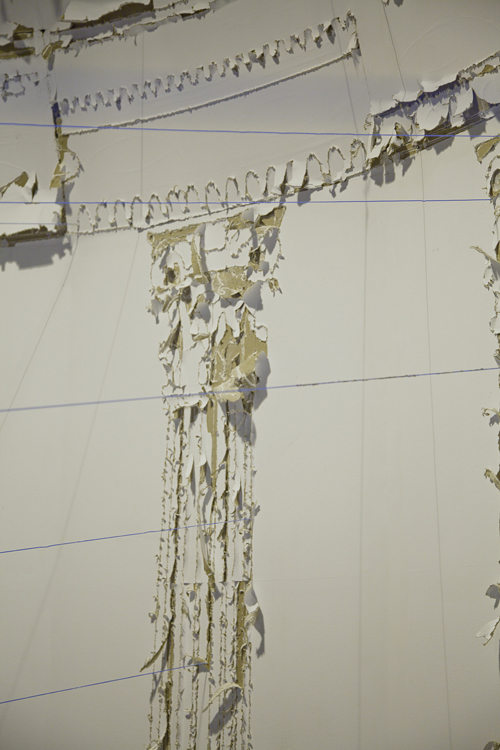
Jesse Potts, “Re-Coil Temple L’amore,” (2012). 40′ x 25′ x 20′. Image courtesy of the artist.
Do you work collaboratively to create the technology that you use, such as the mechanics for the piece Recoil Temple L’amore, which tears away at the walls?
I’ve been very lucky to work with technicians to help CNC route the imagery into the panels. Otherwise, all the tech and machinery involved is these works is a combination of home-grown Arduino programing, geared down pulling mechanisms and hacked or homemade electronic devises that I have built from the ground up.
I don’t want to give too much away, but the patterns, I assume, are controlled by a computer program that is tracing the shapes?
Yes, the patterns have been all been made in illustrator and then routed out with a CNC Router. They are then meticulously put together with the blue cables and then pulled with a timing/pulling mechanism. In Flayed Day Rhythm the timing also corresponds to the images falling out of a ventilation grate.
I watched your video on Vimeo, “test for thesis project.” It’s dated 3 years ago—is that when you started making this work? What foundational background do you bring to your studio practice, such as woodworking, programming or music?
I have created a few projects that make use of the process of wall drawing. The work in that video ended up being part of my 2012 M.F.A. Thesis Exhibition at Virginia Commonwealth University in Richmond, Virginia. In terms of background, my studio process is not totally linear. I like working in all sorts of media, playing with the way things break down and de-materialize.
The sound of the machine in the video is somewhat disconcerting in that it alludes to hidden mechanization of the pulleys at work, yet the viewer is not privy to seeing it operate. The result is one that focuses on the elements of time—particularly the destruction and slow moving decay of a place over time—those moments that one cannot see or witness on a daily basis. Yet, if decades were to pass, a building for example, one might notice it has changed years later…
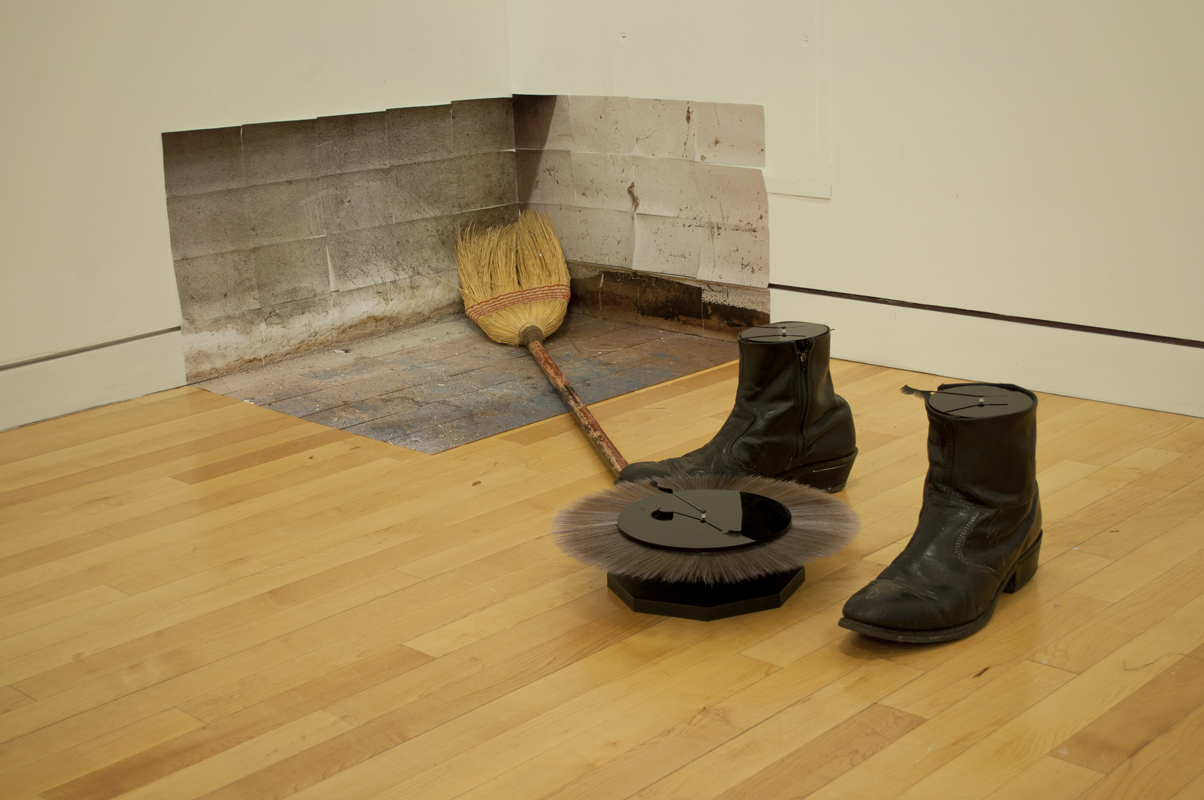
Jesse Potts. “Double Positive — The Levitator.” Image courtesy the artist.
Could you talk a bit about the decision not to reveal the machinery?
This is a really good question. The gear and the mechanics are far too easily fetishized. It can sometimes be a little insular or self-congratulatory if the maker or the viewer gets too sidetracked with the how-to stuff…it kind of limits the conversation. I’m conflicted because I love figuring out how things work.
Yes, there are usually a lot of mechanics at play within the work….motors, pulleys, microcontrollers, electronics, electromagnets etc. As you said, the mechanisms are hidden away and are at times heard but not seen. It is important to me to keep the audience’s attention on what’s happening in the work, both in terms of the physical transformation and the relationships between the various parts. Taking careful consideration of all of the timed components allows the focus of the work to be on the time scale involved. I want to allow room for the imaginative and curious audience member to navigate the work. I think if there is some psychological wiggle room to imagine the unseen it allows them to participate a little more in the piece. I hope my restraint here gives the work a longer lifespan and will encourage viewers to revisit the work.
I see some art historical references in your work, but you tell me if any of these resonate with you: Fischli/Weiss, The Way Things Go, use of everyday objects and kinetics, but less humorous or perhaps Rachel Whiteread’s monuments/morgues. Who else?
The Way Things Go is so great! I love the patience that piece requires to make and to view. It is soooo slow and that is what heightens the expectation. Yes, Rachael Whiteread is a great person to bring up. The melancholic vacancy in her work is really attractive to me…I’m drawn to the coldness and the profound solitude in her work and the fact that those feelings are evoked through domestic spaces and objects—like looking inside the mold of a death mask. All the detail is there, but it’s all inverted with little bits of hair, eyelashes, and residue left in the plaster mold. I see something similar to this in her cast void works.
I’m most attracted to artists that use multiple tactics in their work to shift between genre and process. I love the ways that image, sculpture, media, the quotidian and performance can all be mashed and tweezed and re-mixed in an installation. Artist’s like Ann Hamilton, Bruce Nauman or Jason Rhodes come to mind too.
I think it’s because I like feeling like an accomplice when I enter a space . . . feeling like the very foundation of the work itself is on a fault line . . . like it is shifting right then under your feet as you are experiencing it. And if you were come back later or if you even blink maybe the work begins to transform somehow.
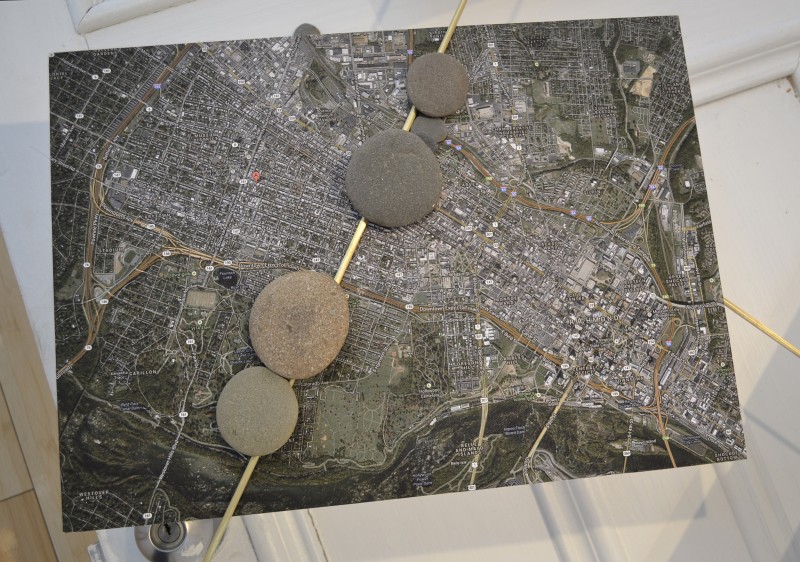
Jesse Potts. “Atlas-xxx-xx-xxxx.” Image courtesy the artist.
I see a somewhat sublime theme in your work that taps into phenomenology such as melancholy, decay and dystopia. Alternately, what are some of the landscapes, environments or places that inspire your work more directly?
I am someone who responds to my immediate surroundings, so where I am living oftentimes has a large impact on the work. I am curious about the ways time and the particularities of a place inform and impact the communities that I have lived in. I am also very curious about the ways architecture and style are culturally absorbed and relentlessly deejayed, co-opted and morphed. Not just for the sake of style, but rummaged through for symbolic and cultural cues that can be lifted out of context like the way you might collect rocks or sand from places you’ve visited.
When working on Temple L’amore, I was living in Richmond, VA. It was my first time living below the Mason-Dixon line. It felt very foreign. I would ride my bike through the city, down streets full of grand antebellum mansions and civil war monuments devoted to confederate heroes whose names sounded familiar, but I did not revere. Then I would ride up streets on the other side of town full of modest homes, some in various states of disrepair. The divisions of the city were very palpable and seemed largely based on race and socio-economics—perhaps not uncommon for a city. What made it so striking and disconcerting was the flagrancy of the disparity. I was struck by the relative proximity of poverty and wealth. I rode past capitol buildings and regal homes held up by these great big pillars and high-end row homes with balustrades and columns holding up the conjoined porches— façade after façade. It mimicked a bygone after bygone after bygone era. I began to see the column not just an innocuous architectural element, but also as a symbolic form of strength that for me, quickly became a visual and symbolic barrier. It became very sad to me and almost antagonistic. Ultimately, the column with all its prestige and class, is repurposed and purports itself to be timeless yet harkens back to some past greatness that may have never have really been.
My pieces Temple L’amore and Monument Et. Al. Loop are a way to try to process cultural divides and ideas of transience. Temple L’amore has a hidden mechanical devise that is pulling cables from an image embedded in the surface of the wall. It is a work that, over the course of its exhibition, is slowly becoming and self-destructing at the same time. In that work, the temple-like structure references Marie Antoinette’s bacchanalian temple: at once a barrier of wealth and a decorative structure.
Moving around the country gives me the opportunity to revisit feelings of selfness and placeness. Recently, I moved to Farmington, Maine where I teach and make my work. It is secluded here to say the least. When I walk or bike I imagine time moving in a few different concentric circles…kind of like the guts of a clock, with some parts spinning faster and others slower. Works like Tripping Up Stream and Atlas xxx-xx-xxxx deal with this sensation; the simultaneous feeling of personal time, (what’s happening in your head from moment to moment), cultural time (the happenings of town or societal infrastructure) and geologic time (the way the river cuts through town or links one town to the next). I like feeling all these different gears spinning independently, and feeling a little bit less significant each time I experience a new sensation.
Last spring while I was biking up a particularly strenuous hill, I stopped to rest and met a woman (she was probably 80 or so), tending her own maple syrup sugar-shack. We talked about what it was like to tap the same trees for decades. She was teaching her grandson to use the sap boiler based on the hardness of winter, when in the year to start and stop tapping, and which trees were the sweetest. I find a lot of parallels here to making work and how perhaps choosing which trees are the best to tap for sap is not unlike deciding what questions to ask oneself in the studio.
—
Jesse Potts is based in Farmington, Maine where he teaches studio practice at the University of Maine, Farmington. His work has been shown in several national exhibitions including a recent solo exhibition at Practice Gallery in Philadelphia. He has been awarded several international residency opportunities including the I-A-M: Institut für Alles Mögliche, Berlin and Cité Internationale des Arts, Paris. More about Jesse Potts and his work can be found here: http://jessepotts.net/
